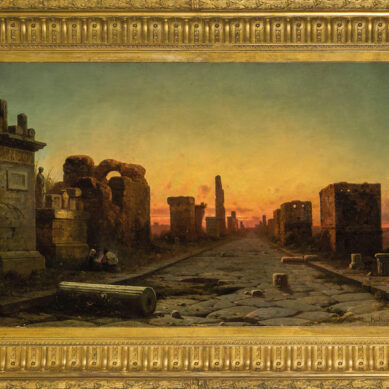You searched
Sculptor
Giulio Monteverde
Are you interested in the sales or the purchase of his artworks?
We buy works of this artist
and of other painters and sculptors from the 16th century to the first half of the 20th century
The Berardi gallery offers a free and without obligation service for evaluation of ancient and modern art . To find your way in the art market, very complex and full of nuances, it is better to rely on a professional consultant who can answer fast and concretely to your needs. The clarity of the answers will resolve effectively the need to estimate or sell an asset.
Contact us immediately without commitment
Answers also in 24 hours:
Giulio Monteverde
Giulio Monteverde
Giulio Monteverde can be considered among the most significant masters – and also with the most successful career – of Italian sculpture of the second half of the nineteenth century. A pupil of Giovanni Bistolfi, Leonardo’s father, he later enrolled at the Ligustica Academy of Genoa under the guidance of Santo Varni, from whom he derived his classicist training.
Won the pensioner in Rome in 1865 he joined the realist current and suddenly the first important commissions arrived: from the monumental sculpture of “Mazzini” of 1874 for Buenos Aires to that of “Vincenzo Bellini” of 1883 performed for Catania, without neglecting the group of ” Il Pensiero ”created between 1908 and 1911 for the monument for Vittorio Emanuele II in Rome.
His smaller sculptures, replicated several times in bronze by French foundries, such as “The youth of Columbus” presented at the Parma Exhibition in 1870, “The Genius of Franklin” awarded at the Milan Exhibition in 1872, were also very successful. and “Dr. Jenner inoculating the vaccine” first sent to the Vienna International Exhibition of 1873.
Parallel the attention to less eloquent genre themes, such as “First games” and “Child who jokes with rooster” whose plaster casts are kept at the Gallery of Modern Art in Genoa, where the technical expertise to the limit of the virtuous of Monteverde is combined with an almost baroque emphasis that makes the two sculptures two real “tranche de vie”.
The comparison with Adriano Cecioni’s “Bimbo con gallo” by Adriano Cecioni is inevitable for the “Child who jokes with rooster”, where the immediacy of Monteverde in motion is replaced by the static simplicity of the Tuscan realist sculptor.
Factsheet: Two years after moving to Rome in 1867, while he was in a state of economic hardship, Monteverde suddenly smiled at success with the group of Children playing with a cat for which they had posed their children as models. The king of Württemberg, on a visit to his studio, commissioned him to translate it into marble, anticipating the large sum of 8,000 lire to the sculptor. The group’s gold medal at the 1869 Munich International Exhibition marked the beginning of his brilliant career.
The immediately following stages were the young Columbus and the Genius of Franklin, “gentle” sculptures that insisted on the theme of childhood and obtained immediate success for their persuasiveness. In 1875, when he modeled the Child playing with a rooster (see plaster in the Galleria d’Arte Moderna di Genova-Nervi; Arditi-Moro 1987, p. 13, Galleria d’Arte 2004, vol. II, p. 579) , Monteverde was developing the group that gave him greater popularity, that Edoardo Jenner who inoculates the smallpox vaccine on his little son who was unanimously considered “a miracle of expression, of evidence, of truth.
The child – the contemporaries noted -, caught on the fly in the instantaneity of his contortions, retains intact, among the manifest signs of dismay, all his delicate childish grace ”(Bettoli 1899, p. 11).
The naturalism of his infantile figures, moreover, had emerged from the time of his first training, when Monteverde had passed from an apprenticeship in the workshop of a wood carver to collaboration with a cabinetmaker in Genoa, attending the school of direct nude in his spare time. from Santo Varni at the Ligustica Academy of Fine Arts. It was then that “he quickly became able to carve cherubs and little angels in wood […] with such evidence of genius and good taste, that he attracted public attention” (Ibid, p. 2).
The naturalistic intent is particularly evident in the Child playing with a rooster, who, repeating the subject of the successful work of Adriano Cecioni (Child with the rooster, 1868, Florence, Galleria d’Arte Moderna), shared his attention to his own daily of the veristic genre scene, while recalling the Baroque tradition.
The classical compositional scheme, a chiasmus, is forced under the expressive urgency of an unprecedented perceptual immediacy and the group appears set on a juxtaposition of open diagonals, offering the viewer multiple points of view, even inviting him to walk around it.
The marble translation was commissioned in Monteverde by Teresa Berra Kramer, a well-known Milanese patriot, former animator of a republican parlor and an established supporter of Mazzini, who dedicated herself after the death of her son (1869) to social activities (Fine Arts 1876, . 226; Arditi-Moro 1987, pp. 56, 73). The destination of the work was perhaps that Pious Edoardo Kramer Foundation aimed at assisting the disabled in work and the establishment of kindergartens for the creation of which Donna Teresa used all of her resources.





